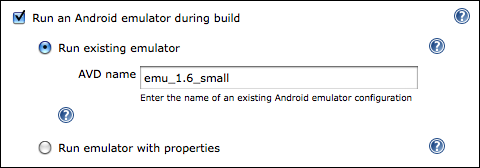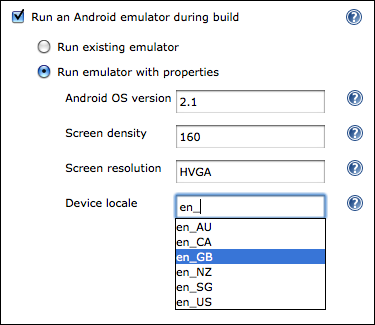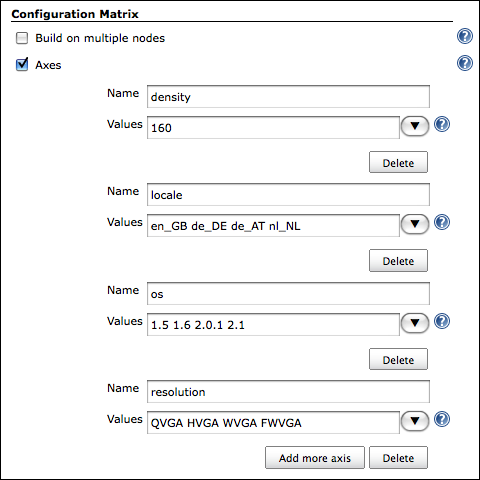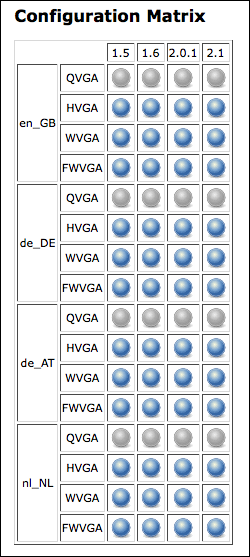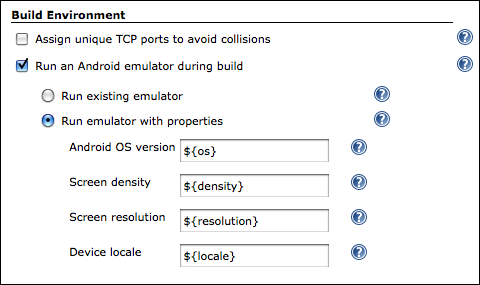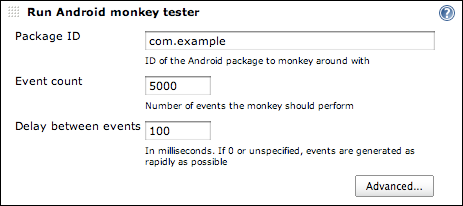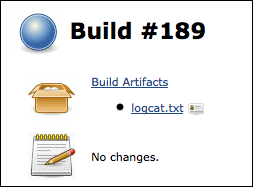Provides numerous features for Android development and testing during Jenkins builds, including:
- Creating Android emulators on-demand
- Running an Android emulator during a build
- Automatically installing the Android SDK on Jenkins agents, where required
- Detecting which Android platforms are required to build one or more projects and installing them automatically
- Generating Ant build files for any app, test, or library projects found in the workspace
- Installing/uninstalling Android packages
- Running the monkey stress-testing tool
- Parsing output from running monkey and marking a build as unstable/failed
Automates many Android development tasks including SDK installation, build file generation, emulator creation and launch, APK (un)installation, monkey testing and analysis...
See also: Android Lint Plugin.
See also: Google Play Android Publisher Plugin.
This plugin lets you automate a number of Android-related tasks during a build:
- Creating a new Android emulator
- Its configuration can be parameterised, including OS version, screen size, locale and hardware properties
- Android SDK dependencies are automatically downloaded and installed
- Running any Android emulator
- Waits until the emulator is fully started-up
- Emulator snapshots can be automatically created
- This allows a very fast startup time for subsequent builds
- This ensures subsequent builds will start from the same clean state
- Logs are automatically captured and saved
- Emulator will be shut down automatically when the build has finished
- Multiple instances of the same emulator are prevented from running concurrently
- Detecting which Android platforms are required to build one or more projects and installing them automatically
- Generating Ant build files for any app, test or library projects found in the workspace
- Installing an Android package onto an emulator
- Uninstalling an Android package from an emulator
- Running the
monkeystress-testing tool - Parsing output from running
monkey- The build outcome can be automatically marked as unstable or failed in case a monkey-induced crash is detected
Jenkins version 2.479.1 or newer is required.
The plugin will automatically download and install the Android SDK, if it's not already installed when a build starts.
This means that no manual effort is required to start running Android emulators with Jenkins.
You can, however, disable automated installation via the "Automatically install Android components when required" option on the main Jenkins configuration page.
View manual SDK installation requirements...
If you install the Android SDK yourself, you must install at least two further components, via the Android SDK and AVD Manager:
- SDK Tools
- SDK Platform-tools
If you only wish to run pre-existing emulator instances (aka Android Virtual Devices, or AVDs), there are no further requirements — only these two components are required.
If you want the plugin to automatically generate new emulator instances, but disable auto-installation, you must install one or more Android platform versions into the SDK.
By default, the SDK only comes with the bare minimum; in this case you will need to separately download each individual platform version you wish to build or test against.
Again, this is done via the Android SDK and AVD Manager tool, accessible via the command line "android", or via the "Window" menu in Eclipse, if you use the Eclipse ADT plugin. From the SDK Manager, you can easily install the desired "SDK Packages".
Generally no global configuration is needed — the plugin will try hard to locate an installed Android SDK whenever it is needed. If one is not found, it will be installed automatically.
See how the SDK is located...
Via the main configuration page, you can optionally specify the location where each build node can locate a copy of the Android SDK.
This can either be an absolute path, or can contain environment variables in the format $``VARIABLE_NAME. This will be replaced at build time from the node's environment variables (see the "Node Properties" settings for each agent), or from the build's environment.
If no value is entered, or the plugin cannot find a valid SDK under the configured path, it will search under the following environment variables on the build node to try and locate a usable SDK:
ANDROID_SDK_ROOTANDROID_SDK_HOMEANDROID_HOMEANDROID_SDK
If nothing is found, the plugin will search on the PATH to attempt to locate a usable set of SDK tools. If, after all these steps, the required Android SDK tools are not found and auto-installation is disabled, the build will be marked as "not built" and will stop.
If you have build agents which are headless (e.g. Linux servers that don't have a graphical user interface), you can still run an Android Emulator even although, by default, the emulator does require a graphical environment.
Just untick the "Show emulator window" configuration option in your job configuration. This is the equivalent of using the emulator's "-no-window" command-line option.
Using an artificial graphical environment...
It is also possible to run the Android emulator UI on a headless build agent by making use of an artificial X server, such as Xvnc.
In this case, a recommended setup is to install both Xvnc and the Xvnc Plugin for Jenkins. With this plugin enabled in your job — and Xvnc configured to run without requesting a password — you can run multiple Android emulators in parallel on a headless agent, while keeping the "Show emulator window" option enabled.
Although the Android Emulator plugin has been designed to ensure it always runs after an Xvnc server has been started, the Xvnc plugin does not wait for the Xvnc server to be fully up-and-running before handing control over to the Android Emulator plugin.
For this reason, you may want to delay emulator startup by a few seconds (e.g. three to five), giving the Xvnc server time to finish starting-up before attempting to launch an Android emulator into it. To do so, enter the desired number of seconds in the "Startup delay" field under "Advanced" options.
In addition, while the Android Emulator plugin requires the Port Allocator Plugin, there is no job configuration required for this; everything is handled automatically — you need not select the "Assign unique TCP ports" checkbox in the job config.
After ticking "Run an Android emulator during build", you will be asked whether you want to run an existing AVD, or whether you want to create a new one on-the-fly with certain properties.
Using an existing emulator for a job just requires that you enter the name of the AVD you want to be started. This AVD must exist on each build node the job will be executed on. Existing AVDs are found in your $HOME/.android/avd directory and can be listed using the "android list avd" command.
As with all other properties, you can enter environment variables here using the format $``VARIABLE_NAME.
Alternatively, if you don't have a particular AVD accessible on each build node, the plugin can automatically generate a new emulator if one doesn't already exist:
Each property is mandatory, aside from the device locale. If this is not entered, the Android emulator default locale of US English (en_US) will be used when starting the emulator.
Each field will auto-complete with the default Android SDK values, e.g. 120, 160, 240dpi densities and named screen resolutions including QVGA, HVGA, WVGA etc. However, you can enter your own values if you wish to use a custom OS image, screen density, resolution or locale.
Screen resolutions can be entered either using the named values, or as a "width times height" dimension, e.g. 480x800.
You can specify multiple hardware properties such as the heap size for each Android app, or whether the device has a GPS by clicking the button "Add custom hardware property" and entering the values. See the inline help for more details on the values to enter.
Using Google Maps and other SDK add-ons...
As mentioned above, the "Android OS version" field will auto-complete to existing SDK versions such as "1.5" or "2.2".
However, it is possible to enter different values in this field, for example if you want to use an Android SDK add-on that you have installed, e.g. the Google APIs add-on or the Samsung GALAXY Tab add-on.
In these cases, just enter the appropriate value given by the "android list target" command. For example:
- The Google APIs add-on, based on an Android 1.6 emulator:
Google Inc.:Google APIs:4 - The Samsung GALAXY Tab add-on, based on an Android 2.2 emulator:
Samsung Electronics Co., Ltd.:GALAXY Tab Addon:8
The real awesomeness of this plugin comes when used in conjunction with a multi-configuration job type.
By using the "Run emulator with properties" setting, in conjunction with one-or-more matrix axes and the Android Emulator plugin's variable expansion, you can generate and test with a large number of distinct Android emulator configurations with very little effort.
To give a full example, if you want to test your application across multiple Android OS versions, multiple screen densities, multiple screen resolutions and for several target locales, you might set up your matrix axes as follows:
As each of these axis names (i.e. "density", "locale", "os", "resolution") are exported by Jenkins as environment variables, you can make use of these when launching a new Android emulator:
When the build executes, this would automatically generate and allow you to test your application against 64 unique device configurations.
However, you should note that not all combinations are valid. For example, a WVGA (800x480) resolution device makes no sense with a screen density of 120 (unless you have superhuman eyesight).
For this purpose, you can use the "Combination Filter" feature, which tells Jenkins which combinations of the matrix axes are valid. In the case of screen densities and resolutions, a configuration like this should instruct Jenkins to only build for configurations which make sense:
(density=="120").implies(resolution=="QVGA" || resolution=="WQVGA" || resolution=="FWQVGA") &&
(density=="160").implies(resolution=="HVGA" || resolution=="WVGA" || resolution=="FWVGA") &&
(density=="240").implies(resolution=="WVGA" || resolution=="FWVGA")
Note that each variable refers to one of the matrix axes, not an Android Emulator plugin property.
For convenience, the plugin places a number of variables into the build environment relating to the emulator in use:
| Variable name | Example value | Description |
|---|---|---|
ANDROID_SERIAL |
localhost:34564 |
Identifier for connecting to this AVD, e.g. adb -s localhost:34564 shell |
ANDROID_AVD_DEVICE |
localhost:34564 |
Identifier for connecting to this AVD, e.g. adb -s localhost:34564 shell |
ANDROID_AVD_ADB_PORT |
34564 |
Port used by ADB to communicate with the AVD (random for each build) |
ANDROID_AVD_USER_PORT |
40960 |
Port used to access the AVD's telnet user interface (random for each build) |
ANDROID_AVD_NAME |
hudson_en-GB_160_HVGA_android-7 |
Name of the AVD running for the build |
ANDROID_AVD_LOCALE |
en_GB |
Locale of the AVD |
ANDROID_AVD_OS |
2.1 |
OS version of the running AVD |
ANDROID_AVD_DENSITY |
160 |
Screen density in dpi of the AVD |
ANDROID_AVD_RESOLUTION |
HVGA |
Screen resolution, named or dimension, of the AVD |
ANDROID_AVD_SKIN |
HVGA |
Skin being used by the AVD, e.g. WQVGA432 or 480x800 |
ANDROID_ADB_SERVER_PORT |
51292 |
Port that the AVD server for this build is running on (random for each build) |
ANDROID_TMP_LOGCAT_FILE |
/var/tmp/logcat_943239.log |
Temporary file to which logcat output is written during the build (random for each build) |
JENKINS_ANDROID_HOME |
/home/jenkins/tools/android-sdk |
The path to the Android SDK being used for this build (optional) |
ANDROID_HOME |
/home/jenkins/tools/android-sdk |
The path to the Android SDK being used for this build (optional) |
Now that you have an Android emulator running, you'll probably want to install one or more Android applications (APKs) and start running some tests.
Basically, whenever you want to call adb as part of your build, just call it as you normally would, e.g. adb install my-app.apk.
If you're using Android's default Ant build system, you should specify the sdk.dir property, to tell Ant it can find the Android build scripts:
Just add "sdk.dir=$ANDROID_HOME" to the "Properties" field of your "Invoke Ant" build step.
Documentation for older plugin versions...
Normally, when running an Android application using Eclipse or the command line, either your APK is automatically installed (because there is only one emulator/device attached to your PC), or Eclipse allows you to choose from a list. Similarly, when building from the command line, installation is done with a command like: "adb -e install -r my-app.apk", where "-e" specifies the emulator (or "-d" a USB-attached device).
However, as Jenkins may be running multiple Android-related builds at once, with several emulators running in parallel, it's not possible to automatically determine which emulator should be used. Nor can the user be prompted at build time.
Since version 1.15, the ANDROID_SERIAL environment variable has been automatically set by the plugin. Because the adb tool automatically uses this variable to determine which Android device to communicate with, you no longer need to pass in parameters like "-s" or "-e" to adb.
Furthermore, since version 2.13, if the plugin detects (or automatically installs) your Android SDK, the SDK tools and platform tools directories will be prepended to your $PATH during a build. This means you don't have to supply the full path to tools like adb or monkeyrunner, even if those tools would not normally be on the $PATH.
The default build system for Android is Apache Ant, which is well supported by Jenkins.
When calling targets like "ant install" or "ant run-tests", the Android build system allows you to use the adb.device.arg property to specify where the application should be installed to.
To make use of this in an "Invoke Ant" build step, just add the following to your Ant "Properties" section:
adb.device.arg="-s $ANDROID_AVD_DEVICE"
If you aren't using Ant, but want Jenkins to run adb commands for you via an "Execute shell" build step, the process is similar.
To install, use the ANDROID_AVD_DEVICE environment variable with the -s flag:
adb -s $ANDROID_AVD_DEVICE install -r my-app.apk
This would be automatically expanded by the shell to something like:
adb -s localhost:34564 install -r my-app.apk
The same principle applies for any other adb commands you wish to perform, for example to start running tests:
adb -s $ANDROID_AVD_DEVICE shell am instrument -r -w com.example.tests/android.test.InstrumentationTestRunner | tee test-result.txt
When compiling an Android project, you must have all the prerequisite Android platform images installed. For example, if you have an Android app which relies on an Android library project, plus you have a unit test project — these may all be targeting different Android SDK versions, all of which must be present at compile time.
Normally, with the (deprecated) Ant build system, these target versions are specified in either a "project.properties" or "default.properties" file.
Since version 2.1, the plugin provides a "Install Android project prerequisites" build step for the Ant build system, which automatically detects the target versions in the build workspace, then automatically installs any of the corresponding Android platform images that are not yet installed.
This build step requires no configuration — just add it before the build step that compiles your Android projects.
For the Gradle build system, I would recommend including the Android SDK Manager Gradle Plugin in your project. You may have to use JitPack to get the latest version.
If you only build a project in Eclipse or using another IDE, you may not have the required Ant build files created or checked into your repository.
Since version 2.8, the "Create Android build files" build step will automatically find any Android app, library or test projects in a build's workspace and will create the build files for them, using the appropriate "android update project" command.
Since version 1.9, the plugin can automatically install an APK on the started emulator for you.
Under the "Build" section of your job configuration, select "Add build step" and choose "Install Android package".
In the "APK file" field that appears, enter the filename of the APK you wish to install. When a build runs, the APK will be automatically installed after the emulator has started up.
Note: It is also possible to use this build step without having started an emulator via this plugin — you can install an APK on an attached device or other emulator.
The plugin provides a Build Step called "Run Android monkey tester" which will run the monkey stress-testing tool against the given Android package.
The output is saved to a file — by default "monkey.txt" in the root of the build workspace.
Don't forget to archive this file by using "Archive the artifacts" option under "Post-build Actions" if you want to keep the monkey output for future reference!
Also provided is a method of parsing the output of the monkey testing tool.
Under the "Post-build Actions" section, enable the "Publish Android monkey tester result". No further configuration is required — by default the plugin will search for "monkey.txt" in the root of the build workspace, parse the file's contents and display the result on the build page.
If the monkey output reveals your Android application crashed or caused an "Application Not Responding" situation, the build will be marked as UNSTABLE.
You can, of course, specify a different filename (including the use of variables) or change the "Set build result" option to mark the build as a FAILURE rather than just UNSTABLE, or leave its status untouched in case the monkey information does not indicate success.
Once the emulator is ready for use, its log is captured until the build finishes. This corresponds to the output of "adb logcat -v time", i.e. the main log output including timestamps.
This will be archived automatically as a build artifact, with the name logcat.txt.
View known issues...
This plugin is currently still only compatible with Freestyle jobs — Pipeline support is planned!
The new-and-improved emulator engine — first released as part of SDK Tools 25 (and Android Studio 2.0) — is supported as of version 3.0 of this plugin.
However, the Quick Boot feature (formerly known as snapshots) is currently not supported, as the command line tools do not appear to support this.
Due to a regression in SDK Tools r12 and r13 (see Android bug #18444), running any builds with the "Use emulator snapshots" option enabled (which is the default), would likely fail to load in the state you expect. For example the emulator may not be ready for use, and the screen may not be unlocked.
To avoid this, either keep using r11 or earlier, or update to r14 or newer. However, if you update, you will have to manually delete all existing snapshot images and allow this plugin to re-create them.
See the Known Issues page on the Android Tools site for more information.
Similarly, snapshot support does not fully function for Android 4.0 until SDK Tools r15. An initial snapshot can be created, but subsequently loading from that snapshot will crash the emulator immediately. Earlier Android versions are not affected, i.e. you can still use snapshots with Android 3.2 and earlier. Upgrading to SDK Tools r15+ should fix this.
As a workaround, you can also uncheck "Use emulator snapshots" in any jobs where you are seeing problems.
New AVDs cannot be generated and run if Jenkins is running as a Windows service, using the "Local System" account (see JENKINS-7355).
- Workaround: configure the Jenkins service to "run as" a real user
If running Jenkins as a service on Windows 7 or newer, you may find that while the plugin can start an emulator, its user interface may not appear, even if configured to do so.
This is due to something called Session 0 Isolation, which prevents services from starting UIs for security reasons.
If you really need to see the emulator UI, you can either run Jenkins not as a service, or add an agent node to Jenkins (e.g. launch agent via JNLP on the same machine) which will bypass this isolation.
AVDs can, on occasion, time-out unexpectedly or stop responding during a build, e.g. when trying to install an APK (see JENKINS-7354).
- This is generally caused by bugs in the ADB process. It can be prone to hanging or crashing. Over time, more safeguards have been added to the plugin, including timing-out after a while and isolating ADB instances, so this shouldn't happen too often.
This should also be more stable with version 3.0 of this plugin, which allows the new emulator engine to be used.
Sometimes the emulator process does not shut down fully at the end of a build (requiring a kill -9 on Linux); the plugin sends a console command to terminate the emulator and the UI window closes, but the actual emulator process does not die.
- This issue will be fixed once JENKINS-11995 is implemented.
- If your agent is running Linux, you may be running into Android issue #17294
In this case, there is a workaround assuming your build doesn't need to use the emulator's audio input:- Add a custom hardware property called "
hw.audioInput" with the value "no"
- Add a custom hardware property called "
- Support for the Pipeline Plugin is planned
- Within the 'android-emulator' component of Jenkins' issue tracker you can:
Please have a look at CHANGELOG.md.

